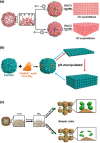Protein cages as building blocks for superstructures
- PMID: 36969478
- PMCID: PMC9996708
- DOI: 10.1049/enb2.12010
Protein cages as building blocks for superstructures
Abstract
Proteins naturally self-assemble to function. Protein cages result from the self-assembly of multiple protein subunits that interact to form hollow symmetrical structures with functions that range from cargo storage to catalysis. Driven by self-assembly, building elegant higher-order superstructures with protein cages as building blocks has been an increasingly attractive field in recent years. It presents an engineering challenge not only at the molecular level but also at the supramolecular level. The higher-order constructs are proposed to provide access to diverse functional materials. Focussing on design strategy as a perspective, current work on protein cage supramolecular self-assembly are reviewed from three principles that are electrostatic, metal-ligand coordination and inherent symmetry. The review also summarises possible applications of the superstructure architecture built using modified protein cages.
Keywords: molecular biophysics; proteins; self‐assembly.
© 2021 The Authors. Engineering Biology published by John Wiley & Sons Ltd on behalf of The Institution of Engineering and Technology.
Conflict of interest statement
The authors have declared no conflicts of interest for this article.
Figures




Similar articles
-
Controllable coordination-driven self-assembly: from discrete metallocages to infinite cage-based frameworks.Acc Chem Res. 2015 Feb 17;48(2):201-10. doi: 10.1021/ar5003076. Epub 2014 Dec 17. Acc Chem Res. 2015. PMID: 25517043
-
Functional Capsules via Subcomponent Self-Assembly.Acc Chem Res. 2018 Oct 16;51(10):2423-2436. doi: 10.1021/acs.accounts.8b00303. Epub 2018 Sep 12. Acc Chem Res. 2018. PMID: 30207688
-
Cooperative Assembly of Asymmetric Carbonaceous Bivalve-Like Superstructures from Multiple Building Blocks.Research (Wash D C). 2018 Sep 2;2018:5807980. doi: 10.1155/2018/5807980. eCollection 2018. Research (Wash D C). 2018. PMID: 31549033 Free PMC article.
-
Molecular Cavity for Catalysis and Formation of Metal Nanoparticles for Use in Catalysis.Chem Rev. 2022 Jul 27;122(14):12244-12307. doi: 10.1021/acs.chemrev.1c00811. Epub 2022 Apr 19. Chem Rev. 2022. PMID: 35438968 Review.
-
Molecular Recognition in the Colloidal World.Acc Chem Res. 2017 Nov 21;50(11):2756-2766. doi: 10.1021/acs.accounts.7b00370. Epub 2017 Oct 6. Acc Chem Res. 2017. PMID: 28984441 Review.
Cited by
-
Ferritin cages as building blocks for higher-order assembly through copper-sulfur bonds for HER analysis.RSC Adv. 2024 Aug 7;14(34):24791-24796. doi: 10.1039/d4ra02931c. eCollection 2024 Aug 5. RSC Adv. 2024. PMID: 39114434 Free PMC article.
References
-
- Uchida, M. , et al.: Biological containers: protein cages as multifunctional nanoplatforms. Adv. Mater. 19(8), 1025–1042 (2007)
-
- Whitesides, G.M. , Grzybowski, B. : Self‐assembly at all scales. Science. 295(5564), 2418–2421 (2002) - PubMed
LinkOut - more resources
Full Text Sources

